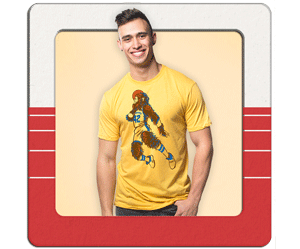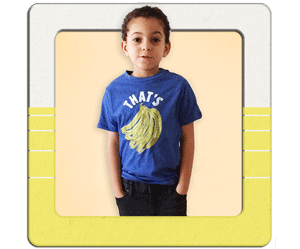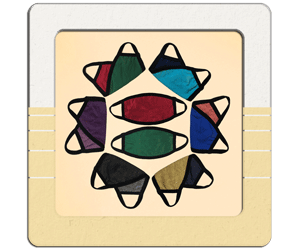Free US Shipping Over $75 • Free Returns • Shop Now
Free US Shipping Over $75 • Free Returns • Shop Now
Shop

The History of T-shirts | How Graphic Tees Became a Thing
April 25, 2023 9 min read
What we commonly think of as the basic wardrobe staple, t-shirts have more of an unexpected and interesting history than one might imagine.
From hygienic garments in the Middle Ages to socially active punk movements in the 70s, t-shirts have become an integral part of common culture through their history. Graphic tees have only been around for the last 6o years or so, but the impact they have made socially, economically, and politically speaks to their impression on generations past and present.
As someone who has completely given into the classic comfort of t-shirts, I myself own likely close to one hundred iterations of this quintessential closet centerpiece. If you were to count, you’d find at least ten high-school t-shirts in various shades of gray and purple, images of penguins and punny slogans plastered across them all. There’s another handful dedicated to my college, commemorative to another four years of my life. There’s the onslaught of graphic tees for every occasion: Gilmore Girls jokes, old Panic! At The Disco concert tees, vintage Dr. Pepper designs, other references to pop culture.

In my self-proclaimed expansive and likely overfull collection, there are also a series of my dad’s old t-shirts. Amidst the others repping iconic characters of my dad’s childhood, Teenage Mutant Ninja Turtles and the like, one has stood the test of time: a Boston Bruins dark gray t-shirt that falls to my knees. The graphic on the front, of a grizzly bear surrounded in a golden yellow hue, started to chip off like old paint a couple years into my wearing of it. With every wash, I watched my beloved bedtime t-shirt come ever-so-slowly apart as the graphic pulled loose from the backing fabric. Loose threads spilled out from the pattern and a gaping hole formed in the front. The shirt made its way into storage once the bear design tore completely from the rest of the fabric; too sentimental to let go, but too damaged to wear.
In a similar vein, I have this old t-shirt of my grandfather’s that I don’t think he ever wore. It’s a black ACDC band tee, and no, it wasn’t made in the 70s. Gildan, I think; probably early 2010s. When he passed at the end of 2018, the shirt came with me everywhere; to every hotel stay, to college where I wore it once a week at least, always back home whenever I came to visit. This habit lasted until just a few months ago.

That’s the quintessential thing about t-shirts. They have become more than just thread, more than a sanitary layer or an undershirt. They are declarations of who we are and what we believe in, they are memories and history sewn with thread.
From Drab to Fab:
The modern t-shirt was not always the graphic-printed, stylistic medium of personal expression we now know it to be. The earliest t-shirts appeared in the Middle Ages. They were a T-shaped cuts of cloth, usually made from linen or cotton, that were worn by wealthier members of society as a means for protecting the skin and allowing for more hygienic cleansing processes.
Birthed by American laborers and military men in the 1920s out of a necessity for lighter weight clothing, our modern conceptualization of the popular style came to be. These t-shirts were made from a soft cotton and were tailored for a tighter fit on the body to give these men a shirt that could function both under their uniforms and as outerwear when necessary. Thus, t-shirts lived a life as mere underclothes for their first few decades.

Until – enter the rise of the bad boy. In the 1950s, cinema took to casting hunks like Marlon Brando and James Dean as rebellious men on a mission. And what else would they be clad in but the humble, white t-shirt? Represented for the first time as outerwear in a public setting, suddenly, t-shirts skyrocketed into cultural fame. T-shirts were instantly associated with the mysterious beauty of rippling muscles and perfectly tousled hair. Modern society was hooked. History has repeated itself once again in the gritty, visceral comedy-drama The Bear on FX, and Jeremy Allen White's perfectly tailored white tee.
More than Just a Shirt:
Now a symbol of “coolness”, t-shirts became a foolproof way to spread messages in a nonverbal manner. “Technological advances in silk-screen printing in the early 1960s made it easy, fast and inexpensive to print designs onto shirts. By the 1970s, consumers could have personalized, custom-made T-shirts. Businesses soon realized the potential of T-shirts for marketing, as did brands and music management companies” (Vogue, 2019). Suddenly, everyone and their mother wanted in on t-shirt-wearing, and the understated garment constructed by the need for cooler outerwear became the epitome of classic American cool.

1970s New York City: the infamous club, CBGB’s, became known as the ‘undisputed birthplace of punk’ and created a home for nearly every big name we know and love today. Think Beastie Boys, the Misfits, the Ramones, Talking Heads, Blondie, the list goes on and on. (Wawzenek, 2014). CBGB’s was instrumental in solidifying the punk community and bringing their sound to the forefront. With steadfast roots in alternative culture and the backing of this prominent club, punks transformed the now-popular graphic t-shirt into a symbol of active rebellion. Arturo Vega, creative director for the Ramones, designed their iconic Presidential Seal Ramones T-shirt in 1976, which has gone on to become one of the most well-recognized and popular designs in the forty years to come.

As “scuzzy punk rockers who played fast and furious”, Vega wanted to embrace the band’s outsider status amidst popular culture at the time. He is quoted: “’I came up with the Seal because I saw them as the ultimate all-American band…. [the Seal] symbolizes strength and the aggression that would be used against whoever dares to attack us’” (Boyd, 2016). The resulting design of the simple black t-shirt with the band members’ names inside a white Presidential Seal was a fast indicator of the public preference towards methods to attaining “coolness”. While modern avenues seek to distribute new prints of these tees, it’s important to remember that punk rock started as a group of (sometimes intentionally) misunderstood musicians with things to say about social and political issues; they have real substance. Other examples of this sense in marketing punk culture came with Nirvana’s smiley face tee, said to have been designed by Kurt Cobain himself, along with the iconic red lips and tongue of the Rolling Stones.
That’s right, punk was global. London saw a similar breakout of punk culture with the rise of the Sex Pistols in 1975. Their lead singer John Lydon, stage name Johnny Rotten, was relatively famous for donning Marlon Brando-esque white t-shirts, smattered with rips, stains, and all other sorts of nontraditional appliques, many of which were created by influential fashion designer, Vivienne Westwood. Mother of Punk herself, Westwood designed clothing for the Sex Pistols and other bands in the punk scene throughout the 70s and forward into more modern times.
![]()
Her work hit the runway in 1981 and drove a clear path for the signs of street punk that blossomed in the 80s: Dr. Martens, plaid, studs, fishnets, leather. Westwood’s designs and Rotten’s attitude signified a step away from traditional views of attraction and glamour (Lister, 2017). There’s even a shirt of his from the 1970s, notably not washed since, that was selling in 2016 for £7,000 (Mirror, 2016).
Now, if you think £7,000 for an old t-shirt is out of this world, consider the Beatles/Nike Revolution t-shirt from 1987. This t-shirt is currently selling for near $50,000, and there are even more expensive t-shirts made from crocodile skin and diamonds that go for the price of some houses (Phillips, 2021). It’s mindboggling to the average person to pay this much money for a vintage t-shirt, but there’s a story here too.

When you have a band as insanely popular as The Beatles in collaboration with another huge company like Nike, then add in controversy over an ad campaign involving Michael Jackson, the price of related items can skyrocket. If the piece was made in a small batch, you can expect the price to raise even more (Worthpoint, 2019). Toss in celebrities that can pay for them and brands that hop on the bandwagon too, and suddenly you have a culture of popularized “vintageness” in correlation with specific t-shirts and their unique histories.
The Ramones Presidential Seal T-shirt design, along with these various other inspirations and icons, awakened a generation of youths across the world interested in stepping up to fight for what they believed in, addressing it with aggressive music and loud t-shirts. From the Vietnam War to animal rights, punks were now utilizing their clothing to signify their political and social standings and to “fight the system”.
Maybe one of the lesser-known subcultures of this movement is the straightedge community. This group was compromised of a lineup of hardcore bands, namely Minor Threat, and their cumulative friends and fans who vowed to never drink, smoke, or eat animal products. Minor Threat’s song, “Straight Edge”, emphasized the band’s blatant distaste for the vice-ridden lifestyle many punks of the time were finding themselves entrenched in. My dad was the bassist of Reach the Sky, one of the bands who played in Boston for the first ever National Edge Day on October 17, 1999. Other bands in attendance included Ten Yard Fight, Bane, and Floorpunch, all coming together to celebrate this alternative lifestyle and set of morals.
The straightedge movement falls in a similar path with the more popular D.A.R.E program, founded in L.A. in 1983. This was a program that targeted students in an effort to address drug issues in the area. D.A.R.E was backed by police and was running in “75% of American schools” by the 90s, but that doesn’t mean it worked. In fact, D.A.R.E. was largely ineffectual because of its branding - it was simply too good: “in trying to relate to young people, the graphic design team made a cool logo out of an acronym that accidentally spoke to the feeling of daring to experiment with drugs” (Wright, 2017) rather than staying away from them.

The iconic t-shirt has lived on in the decades since, and I even own one of these D.A.R.E. t-shirts myself. Worn sometimes with the intent of initial goodwill the program strived for, other times with a strong irony, the idea lives on as an indication of the impact of good design and the range of effect a graphic t-shirt can have.
After the punks made their mark on the world of graphic tees, pop culture sank its fingers into the soft cotton to use for its own artistic representations. Take the beloved ballroom dancing-themed rom com of the late 80s: Dirty Dancing (1987). Johnny Castle is frequently pictured in black t-shirt and matching trousers, dancing the night away, while Baby’s father is clad in a white t-shirt and khakis, enforcing rules and generally being a rather hard-shelled man.

With this example of the t-shirt in pop culture, it’s easy to see that while the style gained popularity quickly in mainstream society, color soon began to matter. In Dirty Dancing, the symbolism is clear; the audience is supposed to view Johnny as the endearing bad boy while Baby’s father remains an upstanding citizen, hence the black and white t-shirts attributed to each character. This theory holds true in other classic films like West Side Story (1961) and The Outsiders (1983). In West Side Story, the Jets are outfitted with versions of gray and white t-shirts, while the Sharks rep reds and purples. Although this film ties color into race and ethnicity, the result is similar: differences in the color of t-shirt worn by different people have come to represent their societal standing.
The Impact of Solid Threads:
I’ve been working for Solid Threads since the summer of 2020. I print our designs on buttery soft blends of mostly cotton, with some poly and rayon added in for authentic vintage softness. I fold, package, and ship hundreds of t-shirts a week. The process is repetitive and meditative. There’s a certain way I like the sleeves to lie, a certain position way for the creases to should fold when I pile shirts atop one another. Our store stocks likely thousands of blanks in our in-house stockroom at a time, and five days a week, I am surrounded by the rainbow of dyes. I could likely move through the stacks blindfolded, placing my hand over the piles, determining which was a ‘triblend’ (our catchy tag for the “buttery soft” 50/25/25 cotton-poly-rayon blank) and which was a 60/40 cotton-poly style, which were the women’s styles T-shirts or the children’s tees.
To my boss, founder and owner of the company, Solid Threads is about more than just selling t-shirts: “Solid Threads is a sojourn of seeking, 20+ years in the making, fueled by an aversion to conformity, sewn upon the humblest of undergarments, the t-shirt, worn closest to our chests… giving voice to my heart” (Solid Threads). For Brian, creating cool graphic t-shirts is a passion born out of a need for the escape of corporate America. It is a drive to foster connection and find community, to educate and to celebrate. Now twenty-two years into the game, Brian has been through one hurricane, two features on It’s Always Sunny in Philadelphia, nearly three years of selling his designs on the streets of Hoboken, and more. Creating these t-shirts, for Brian, is about advertising for the things he believes in, along with connecting to what truly makes him happy.
Thanks for reading!
Lily Tammik
Leave a comment
Comments will be approved before showing up.






